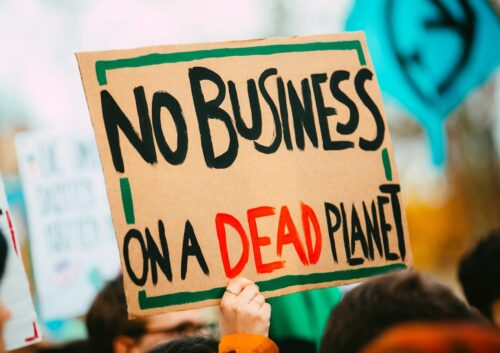
The Public Broadcasting System (PBS) News ran a story claiming climate change has caused or contributed to wildfires currently plaguing New York and New Jersey. This is false. [emphasis, links added]
Wildfires have plagued both states throughout their histories, so the present fire season is not unusual.
Also, real-world data shows the acreage lost to wildfires in the United States has declined sharply since the early part of the 20th century.
The PBS News story, “The role of climate change in an unusual outbreak of wildfires in the Northeast,” consists of William Brangham, correspondent, producer, and substitute anchor for the PBS News Hour, interviewing Hilary Howard, a climate change reporter for the New York Times and Rocky Hazelman, a New Jersey farmer who discussed a drought the region has experienced.
At the outset, Brangham asserts:
For years, wildfires across the American West have served as an urgent reminder of the threat posed by extreme weather, which is often made worse by climate change. But over the last few weeks, nearly 3,000 miles across the country, fires have engulfed parts of the Hudson Valley, stretching between New York and New Jersey, sending smoke into New York City, reducing air quality and turning the skyline a hazy gray.
Often driven by high winds the nearly 5,000-acre Jennings Creek fire has gained ground because of an unusually severe drought that’s occurring on the East Coast.
…
As many people know, this is not a region that is used to wildfires.
With Howard chiming in: “Dry conditions or a drought. They are the reason for the fire or the reason the fire spreads so rapidly. Right. So, it starts with global warming.”
The problem is neither Brangham nor Howard are climate experts, they provide no evidence for their claims that the present drought or wildfires are unusual or are driven by climate change – because there is none – and their claims ignore both the history of wildfires in the two states and are debunked by data on droughts and wildfires across the United States.
Every region of the United States suffers droughts of varying severity periodically. No state or region has been drought-free throughout its history.
As longtime farm families can attest, drought has affected farmers across the Northeastern U.S. periodically, just as it has farmers across America.
New York and New Jersey experience some degree of drought every two to three years on average over some portions of the states with sustained or more severe droughts occurring every few decades.
Wildfires are also not uncommon in the history of New York and New Jersey. As an article on New Jersey’s Forest Fire Service noted in 1999:
Nearly 40% of the [New Jersey] is still in commercial forestland. Its pine barrens, located in the southern part of the state, contain over 1 million acres of highly combustible trees and brush. Another 13% is in parks, recreation areas and watersheds. Numerous farms, orchards and gardens are scattered throughout the state.
With all that forested land, wildfires, some of them orders of magnitude larger than the present fires, have been recorded back to colonial times, as the same article details:

What’s true for New Jersey is equally true of New York, with wildfires many much larger than the present fire recorded across its history. As an article in the Adirondack Journal reports:
The Adirondacks have a long history of epic blazes. While there are no recent comparisons with the terrible devastation faced by the West, fire is no stranger to the vast North Country woodland. Whenever drought conditions exist, there is a heightened risk for fire. Following disastrous fires around the turn of the 20th century, especially those of 1903 and 1908, measures were established to prevent and detect fires, eliminating the scale of destruction that occurred in the Adirondacks a hundred years ago.
There is no trend in increasing drought or wildfires across the Northeastern U.S., or in New York and New Jersey, more particularly, so there is no evidence whatsoever that climate change is exacerbating the risk of wildfires there.
Thus, Brangham’s and Howard’s assertion that there is such a connection is pure speculation or alarmist opinion, not supported by facts on the ground.
In fact, for the U.S. as a whole, drought is in a fairly sustained decline.
As discussed in Climate at a Glance: Drought, the United States set records in 2017 and 2019 for having its smallest percentage of land area experiencing drought conditions and has recently undergone its longest period in recorded history with fewer than 40 percent of the country experiencing “very dry” conditions.
Indeed, the U.N. IPCC reports with “high confidence” that precipitation has increased over mid-latitude land areas of the Northern Hemisphere (including the United States) during the past 70 years, while the IPCC has “low confidence” about any negative trends globally.
Nor are wildfires becoming more common in the United States.
Data from the U.S. National Interagency Fire Center indicate the peak for wildfires over the past century and a half, many in the eastern part of the country, came in the late 1920s and early 1930s (see Figure 1 below), not the 2000s as one may surmise from the false claims commonly made in the mainstream media about increases in wildfires in recent decades.

What’s true of wildfires in the United States is also true for wildfires globally with NASA and the European Space Agency both reporting significant declines in the number and amount of acres lost to wildfires since the beginning of the 21st century.
PBS News’ coverage of the wildfires plaguing New York and New Jersey was long on words and anecdotes but short on facts.
One should expect better than a false fire alarm from a news agency funded in part by taxpayers’ hard-earned dollars.
Read more at Climate Realism



















PBS is just like the rest of the M.S. Media pushing Globalism on us with their Fake News Programs and fake news as well